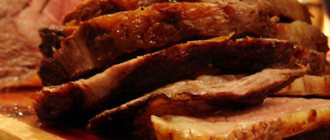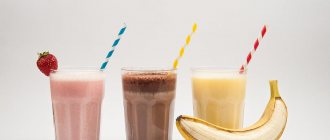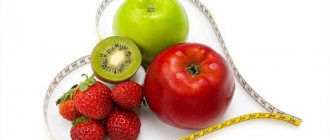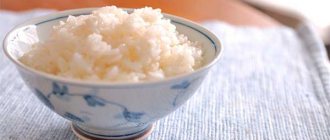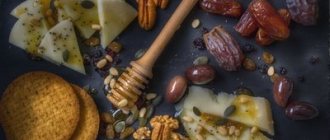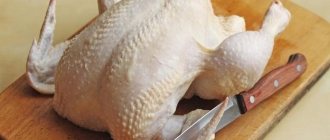Article structure:
- Beef diet, 5 advantages over other diets
- Useful properties, composition and calorie content of beef meat
- Beef diet: Calorie content
- Beef diet recipes and reviews
- Beef on a diet: what reviews say
- Variety of beef diet dishes
Recently, eating beef in a weight loss diet has become very popular. This is a great way to lose extra pounds without harm to your health. In addition, such a diet is perfect for “meat eaters” who cannot live without this product. The beef diet is of the protein type, it is convenient, does not cause hunger, fills the body with energy and shows good results. And these are not its only advantages; you can prepare a lot of dietary dishes from beef, and they are not only healthy, nutritious, but also tasty.
Beef diet, 5 advantages over other diets
Among all types of meat, beef is on par with chicken breast; it is not fatty like lamb or pork, but it is very nutritious. Beef meat helps to establish biorhythms, does not overload the stomach and intestines, maintains the rhythm of life, preventing a person from feeling unwell.
Benefits of the Beef Diet:
- You can prepare beef for your diet boiled, steamed, stewed, or baked on a wire rack or in the oven;
- It is possible to combine meat with vegetables, making all kinds of dishes that will not get boring;
- This diet is great for people who want to lose weight, but cannot live even a day without meat;
- It is a good contrast to mono diets, and at the same time shows good results;
- Beef is considered a “clean” meat, so it is recommended to be used both separately and as part of other diets.
Considering beef in the Dukan diet, we can highlight many recipes for this dish, which allows you to constantly prepare new masterpieces and not choke on the same type of food. During such a diet, a person will not feel hungry, because the nutritional value of a small piece of meat can replace breakfast, dinner and even lunch.
Meat diet menu
To comply with caloric intake and diet rules, you should prepare a menu for several days in advance.
| Menu by days | Breakfast | Dinner | Snack | Dinner |
| 1 |
|
|
|
|
| 2 |
|
|
|
|
| 3 |
|
|
|
|
Useful properties, composition and calorie content of beef meat
In terms of its composition, beef meat is suitable for both men and women. In terms of its value and calorie content, it is close to chicken fillet. The basis of the product is protein, meat also contains water, a small amount of fat, many vitamins, in particular groups B, E, A, PP, as well as amino acids and many minerals. Beef is a source of iron, so it is recommended to include it in diets for anemia.
All vitamins contained in meat are extremely important, in particular the presence of vitamin B12. It just promotes the process of formation of new red blood cells and blood circulation, together with iron, increases the hemoglobin level in the blood. It is also quite significant that when eating beef as part of a diet, you do not receive carbohydrates, which can be converted into fats or increase the supply of glycogen, which retains water in the human body and provokes weight gain.
Beef means meat from cattle that is more than 8 months old. If the animal is slaughtered before this period, then its meat is called veal. Young beef is much more tender and tastier, but due to the fact that the animal has to be slaughtered even before its maturity, many livestock farmers do not do this due to unprofitability. Such meat is more expensive and can be found less often, so you have to be content with beef.
But here, not everything is so simple, not all beef is suitable for consumption, the acceptable age of animals whose meat can be sold in stores and markets should be no more than 3 years. Carcasses of cows and bulls older than this age are sent to meat processing plants and processed into sausages. You should buy beef that is bright red in color, this means that it is young, and therefore the healthiest. Dark color indicates old meat.
Young beef has this appearance; it is recommended to trim off all the greasy veins if the meat will be used in a weight loss diet.
Types of meat
The most useful for losing weight is dietary meat with a low percentage of fat content: chicken, turkey, veal and lean beef. You can eat lean pork and rabbit in limited quantities. A plant-based meat substitute is soy goulash: it can be included not only in a vegetarian diet, but also in a healthy diet.
Soy
Soy goulash is a dry semi-finished product that must be soaked and cooked to obtain a tasty and soft product. It is obtained from defatted soy flour.
Like tofu, goulash is one of the most popular substitutes for animal products for vegans, vegetarians and those who follow a meatless diet or choose a plant-based diet to lose weight. The calorie content of the dry product is about 300 kcal per 100 g, in finished form - less than 100 kcal.
The beneficial properties of soy goulash include:
- rich vitamin and mineral composition (potassium, calcium, iron, magnesium, phosphorus, vitamins E and B);
- the presence of soy lecithin and choline (vitamin B4), which promote normal lipid metabolism and reduce LDL levels in atherosclerosis;
- high content of vegetable protein;
- the presence of phytoestrogens, which reduce the frequency of hot flashes in women in menopause and reduce the risk of osteoporosis, cardiovascular and tumor diseases;
- low calorie content.
In some cases, soy meat can be harmful to health. These include:
- hypothyroidism (isoflavones contained in this plant reduce the production of iodine-containing hormones);
- urolithiasis (frequent consumption of soy promotes the formation of oxalate stones).
There is evidence that excess soy consumption can negatively affect cognitive function (thinking, and to a lesser extent, memory and attention).
Completely replacing meat with soy goulash without vitamin supplements is bad for health due to vitamin B12 deficiency.
Chicken
Chicken meat contains easily digestible protein, so it is actively used in the diet of athletes. The most useful part of the bird is the breast (fillet): this low-fat product is included both in the daily menu of those losing weight and in special protein diets and fasting days.
Chicken meat protein is 96% digestible and prevents rapid muscle loss due to lack of glucose during the diet. Chicken contains the amino acid glutamine, which calms the central nervous system and reduces the risk of overeating as a reaction to stress.
Chicken fillet contains potassium, phosphorus, cobalt, zinc and chromium, vitamin PP and a large number of essential amino acids. Sufficient consumption of chromium suppresses cravings for sweets and normalizes carbohydrate metabolism. The calorie content of the product is 113 kcal.
To lose weight, you should choose chicken parts without skin, cartilage and fat. In addition to lean breasts, skinned thighs and a small amount of offal (hearts and liver) are allowed.
The disadvantage of chicken is its increased allergenicity. The most popular parts of poultry (legs, thighs, wings and drumsticks with skin) are high in fat and calorie content.
Turkey
Turkey fillet has a slightly lower content of minerals and vitamins than chicken breast, but the balance of proteins and fats in it is more useful for those losing weight. The fat content of skinless turkey fillet is 2.5 times lower than that of chicken fillet, and its protein content is 4–5% higher. The calorie content of the product is 110–115 kcal.
The advantage of turkey meat is the absence of allergens in its composition. Disadvantages include high sodium content, which is harmful for hypertension and kidney disease, and increased meat toughness. Because of this, turkey meat requires more thorough marinating and heat treatment.
Veal
Veal is beef obtained from the slaughter of beef cows between 1 and 12 months of age. Calves are most often slaughtered at 3–4 months of age. Veal is rich in B vitamins (B2, B3, B5, B6), phosphorus, zinc and amino acids. In small quantities (4–16% of the daily value) it contains iron, magnesium, copper, selenium and potassium.
Veal tenderloin is a more dietary type of meat than beef. The product, without fat and bones, contains only 116 kcal and 3.3 g of fat per 100 g. The amount of protein is 20–22 g. Due to its low fat content, the meat is easily digestible, but requires long-term heat treatment and marinade treatment for softness.
Like other types of red meat, veal contains many purines, which are harmful for kidney and joint diseases.
Beef
Beef is less healthy than veal, but has a richer vitamin and mineral composition. It contains a lot of selenium, zinc, phosphorus, potassium and B vitamins. In terms of the concentration of essential amino acids, beef and veal are inferior to poultry meat.
The most useful is tenderloin without fatty layers and films. The protein content in such meat reaches 22-23 g per 100 g, and fat - 5-6 g. The calorie content of beef, depending on the fat content, is 150-190 kcal.
Eating beef is not recommended for older people and patients suffering from arthritis, gout, urolithiasis and atherosclerosis (with high fat content of meat).
Beef is good for those losing weight under 40 who exercise at least 3-4 times a week.
Pork
Pork is traditionally considered a non-dietary and fatty product. However, this product is rich in vitamins (B1, B2, B3, B5, B6 and B12), phosphorus, potassium and selenium. In terms of selenium and thiamine (vitamin B1) content, pork is inferior to healthier varieties of meat - beef and veal.
In dietary nutrition, it is recommended to use only lean tenderloin, loin and shoulder, cleaned of streaks of fat and connective tissue. It contains 20–21 g of protein, 2–5 g of fat and 110–140 calories.
The disadvantages of pork are:
- risk of allergies;
- high fat content and cholesterol content in most pork products;
- a large number of impurities that are added during the growth of the animal;
- danger of infection by parasites due to insufficient heat treatment.
Mutton
Lamb contains zinc, phosphorus, potassium, selenium, B vitamins and amino acids. Even with a small percentage of fat content (removing the fat layer from the fillet), the calorie content of the product is about 150 kcal, and the average piece of lamb is 210–300 kcal per 100 g.
Lamb fat is the most refractory, therefore it complicates the digestion of meat and impairs the function of the gastrointestinal tract (pancreas, liver, intestines and gall bladder). A large amount of purine compounds negatively affects the health of the kidneys and joints.
Duck
Duck has a less rich chemical composition than turkey or chicken. The amount of protein in duck meat reaches 18.3 g per 100 g, and the amount of fat varies from 3–4 g to 38–40 g. The fat content of the meat depends on the breed of bird, the part of the carcass used and the presence of skin.
Meat of lean duck breeds (indo-duck, mulard) without skin can be included in small quantities in the diet menu, because its calorie content is only 120–135 kcal. Other common breeds (for example, Pekingese) have fattier and less healthy meat.
Goose
Goose is the fattest bird. Its meat without skin and strips of fat contains more than 22 g of protein and 7 g of fat per 100 g of product. The fat content of meat with skin reaches 33–38%, and the calorie content is 370–410 kcal.
Duck and goose meat are not recommended for consumption if you have atherosclerosis, a tendency to allergies, obesity, diabetes, hypothyroidism, gastrointestinal dysfunction and liver diseases. Most prohibitions concern fatty breeds and carcass parts.
horsemeat
Horse meat is not a commonly consumed product, although it has a good ratio of proteins and fats (21 g to 4 g for category 2 horse meat). This type of meat is rich in essential amino acids, but contains small amounts of minerals and vitamins.
Horse meat requires long-term heat treatment and is often used dried, dried or smoked.
Rabbit
Rabbit meat, like turkey meat, is a hypoallergenic type of meat. It is a good source of iron, zinc, phosphorus, B vitamins (B3, B4, B5, B12) and essential amino acids. The content of cyanocobalamin (B12) in rabbit meat is higher than in any other type of product.
The calorie content of rabbit meat depends on the category of meat: rabbit of category 1 is fattier (15%) and contains 220 kcal, and rabbit of category 2 is more dietary (9–11%) and contains 183 kcal per 100 g. More than 50% of fats in rabbit meat are to the group of mono- and polyunsaturated, which makes this product even more useful.
Calorie table for common types of meat
| Meat | Protein content, in g per 100 g | Fat content, in g per 100 g | Calorie content of the product |
| Chicken fillet | 23,6 | 1,9 | 113 |
| Chicken thighs (with/without skin) | 17,3/20 | 15,3/9 | 211/162 |
| Chicken drumsticks | 19,3 | 8,7 | 161 |
| Chicken leg | 21,3 | 11 | 185 |
| Turkey breast (no skin) | 24,6 | 0,7 | 111 |
| Turkey thigh (without skin) | 20,4 | 2,4 | 108 |
| Lean veal and beef (fillet) | 20-22 | 3-6,5 | 116–153 |
| Beef on ribs | 11 | 35 | 363 |
| Beef steak | 19,2 | 15,3 | 220 |
| Beef tongue | 16 | 12,1 | 173 |
| Pork tenderloin | 20,7–21 | 2,2–3,5 | 109–120 |
| Pork belly | 9,3 | 53 | 518 |
| Pork loin (meat without fat) | 21,4 | 5,7 | 143 |
| Pork steak (shoulder, meat only) | 18,7 | 5,7 | 132 |
| Mutton | 16,3 | 15,3 | 203 |
| Lamb | 16,2 | 14,1 | 192 |
| Goose (with/without skin and fat) | 15,9/22,8 | 33,6/7,1 | 371/161 |
| Duck (no skin) | 18,3 | 6 | 135 |
| Horse meat (1/2 category) | 19,5/20,9 | 9,9/4,1 | 167/121 |
| Rabbit (1/2 category) | 21,2/22 | 15/10 | 220/183 |
| Minced chicken | 17,4 | 8,1 | 143 |
| Minced pork | 15,4 | 17,2 | 221 |
| Minced beef with added fat or fatty pork | 15,76 | 25 | 293 |
| Soy meat | 17 | 0,3 | 98 |
Offal contains a large amount of vitamins (A, B12) and microelements, but is fattier and richer in cholesterol than lean beef tenderloin and poultry fillet. Eating them during the diet is allowed, but in limited quantities (no more than 1-2 times a week) and taking into account calorie content and contraindications for consumption.
Exotic meats
Some types of meat that are not commonly consumed are no less healthy than poultry, rabbit or veal. These include meat of wild birds and animals (guinea fowl, quail, elk, deer, roe deer, bear and wild boar), ostrich and crocodile meat.
The meat of pigeon, wood grouse, pheasant, partridge, hazel grouse, pheasant, black grouse and goat are too fatty for regular dietary consumption: their fat content ranges from 16% (for goat meat) to 23.8% (for pigeon with skin).
Beef diet: Calorie content
Speaking about caloric content, we will immediately answer the question of whether it is possible to eat beef on a diet; not only is it possible, but it is also necessary. Its energy value brings it to the top positions in the ranking of dietary products. This meat is one of the first to be introduced into special diets. nutrition, it is given to young children, the elderly, and is also included in intensive menus to restore vitality and energy after illness.
As for losing weight, beef also contributes to this process, because it has no carbohydrates and contains very little fat. At the same time, the product is rich in vitamins, minerals and amino acids, which are so necessary for the body, especially during the diet period. The large amount of protein allows the product to be included both in protein diets and in other types that require protein supplementation.
Calories:
- Per 100 g of product ranges from 158 to 250 kcal.
- Proteins: 18 to 25.8 g
- Fat: 8 to 13 g
Which one to choose
Experts believe that an adult needs to eat about half a kilogram of cooked meat every day. But in order for it to bring benefits to the body, and not unnecessary folds on the stomach, it is worth considering some nuances.
Boiled, fried
Meat for weight loss needs to be cooked properly. During processing, the product should not receive additional calories, so the use of oil and any other fat should be abandoned. However, frying in a dry grill pan or with a Teflon coating is allowed from time to time.
The main methods of cooking meat should be boiling, stewing and baking with the addition of natural spices, but with a minimum amount of salt. It wouldn’t hurt to use kitchen gadgets – a steamer, a multicooker or a pressure cooker. In them, the meat will cook faster and retain more of its nutrients.
When choosing meat itself, preference should be given to lean types with the least amount of fat. Because it is full of cholesterol, the excess of which is harmful not only to the figure, but also to the cardiovascular system. Help in the fight against excess weight:
- Turkey meat. It is most popular among nutritionists. This meat is easily tolerated without overloading the digestive system.
- Chicken. Breast fillet contains the most protein and very little fat. From time to time it is allowed to eat other parts of this bird. Just be sure to contain no skin or by-products.
- Rabbit meat. In addition to the “standard” benefits for meat, it contains a lot of phosphorus and calcium. But the specific smell requires a special preparation method.
- Beef. Eating this meat helps prevent anemia, which often accompanies the process of losing weight. However, it is worth considering that it contains more fat than poultry. Therefore, it is better not to partake in a diet containing beef.
The value of other types of meat for weight loss is not very high. Their calorie content is significantly higher due to the animal fat content. Therefore, the process of fighting extra pounds will be in question.
Beef diet recipes and reviews
By following a beef diet, you can lose 0.5 -1 kg daily, but the weight melts only in the first days. With a two-week diet, weight loss occurs in the first half, and the results are consolidated in the second week. Thus, without harm to health, you can lose up to 8 kg in two weeks. It is worth remembering that with any diet you should drink at least 2 liters of water daily, and before starting it, you should consult a doctor. Of course, any diet requires a certain menu, a set of products; it cannot consist of only beef, although some nutritionists also practice this option.
There are many recipes for beef diets, let's look at the most popular ones. The presented menu can be adjusted according to tastes and personal preferences.
- Breakfast: 150 g of cottage cheese and tea. It is worth remembering that the calorie content of cottage cheese depends on its fat content and ranges from 71 to 234 kcal per 100 g.
- Lunch: boiled beef 150 g, tea, 1 apple. You can take any other fruit except banana and grapes, and also cook the meat in a different form.
- Afternoon snack: low-fat yogurt, kefir or fermented baked milk, 200 g, this will be approximately 150 kcal.
- Dinner: Beef 100-150 g, green tea, vegetable salad.
You can arrange the menu at your discretion, the main thing is to adhere to the norm. You can take the average, do not consume more than 1200 kcal per day. Although their number is different for everyone, it all depends on the person’s weight, as well as on his activity. In other words, to lose weight, you must consume fewer calories than you burn in a day. For example, you spend 1600 kcal and consume 1400 kcal, then you won’t have to wait long for results. It is worth remembering about late dinners, the best option is 18-19 hours, you should not overeat just before bed, the optimal minimum is 2-3 hours before bedtime, and preferably 4.
How to eat meat correctly for weight loss
For 5 days
4. Fourth day
For 7 days
The diet for a week is no different from the previous version, but with a small addition: for the remaining two days you should not eat anything except boiled beef and fruit. This will speed up the process of losing weight without harm to your health within a week. Do not forget that any diet, even the most gentle one, is a great stress for the body, so during this period you cannot do without additional vitamins. For these purposes, choose not a specific group, but a complex option with the addition of microelements.
For 10 days
During the diet, you will have to give up foods rich in carbohydrates and some others. This ban includes:
- all fruits and dried fruits;
- cereals and pasta;
- bakery products;
- sugar and its substitutes;
- some vegetables (potatoes, corn, carrots, beets and legumes);
- milk and dairy products;
- sausages;
- canned food;
- store-bought sauces;
- alcohol.
Salt consumption during this period is allowed, but in very limited quantities. To achieve the best result, you should try not to use it. You will have to forget about fats for a while. You will need to exclude all types of oils from your diet except olive oil. It can be added to salads, but not used for frying.
The basis of nutrition during the diet will be:
- meat (all types are allowed, but preference is best given to dietary ones);
- fish (river and sea);
- seafood;
- chicken eggs;
- mushrooms (except oyster mushrooms);
- vegetables (except prohibited ones);
- greenery;
- natural spices;
- tea and coffee without sugar;
- still mineral water.
Meat, eggs and vegetables can be prepared in any way. The main thing is not to use fats and other prohibited ingredients.
Example menu
Depending on individual preferences, you can choose the optimal diet menu yourself. For example, it might look like this:
- Breakfast: one egg omelet with fresh tomato.
- Second breakfast: fresh vegetable salad.
- Lunch: 250 g of stewed rabbit and vegetable stew.
- Afternoon snack: 50 g of boiled chicken fillet and one cucumber.
- Dinner: 200 g turkey steak with a side dish of lettuce, seasoned with olive oil.
If you don’t have time to prepare a variety of dishes, you can do it easier. Every day, boil or bake 500 g of meat or fish and divide into several meals. The side dish can be fresh or permitted vegetables cooked without adding oil.
Recommendations
In order for the diet to bring good results, you should pay attention to the following nuances:
- You can only eat 500 g of meat per day, while there is no limit for fresh vegetables.
- During the diet, you must drink at least two liters of clean water.
- Drink tea or coffee without sugar, but only between main meals.
- The diet should consist of five to six meals. And the last one is three hours before bedtime.
- Servings for breakfast, lunch and dinner should not exceed 300 g, and snacks - 150 g.
Advantages and disadvantages
An undeniable advantage of such a diet is the absence of hunger due to the consumption of large amounts of meat. At the same time, the product will be well absorbed due to the abundance of fresh vegetables, which will also replenish the body’s need for vitamins and fiber.
In addition, with the necessary physical activity during the diet, the figure can acquire a beautiful relief. Because the protein that comes with meat is enough to build muscle mass.
As for the shortcomings, the main one is apathy and a feeling of fatigue due to the lack of “energy” products. These are frequent companions of protein diets, and good motivation helps to cope with them.
Constipation
Another disadvantage is stool disturbance. If you do not follow the drinking regime, it will be difficult to manage without laxatives on a meat diet.
Duration
The duration of the diet can vary from three to ten days. It all depends on the result you want to achieve. There is an opinion that you can follow a meat diet for longer (up to a month). But this is very risky for several reasons:
- Too much dietary restriction can have a detrimental effect on the functioning of internal organs.
- A lack of fats and carbohydrates will affect the condition of the skin and nervous system.
- The body, under conditions of constant “restrictions,” will stop burning excess fat, and will begin to accumulate it.
Therefore, you should not get too carried away with this method of losing weight.
Contraindications
Like any diet that involves dietary restrictions, meat is not suitable for everyone. Therefore, before starting it, it is better to consult a doctor.
This cannot be strictly adhered to:
- during pregnancy;
- for kidney disease;
- teenagers and older people;
- if you have diseases of the gastrointestinal tract.
During a diet, it is preferable to boil meat or bake it in the oven. This way it will retain maximum nutrients and be minimally fatty.
For example, chicken soup with vegetables is rich in minerals and vitamins. Let's tell you how to prepare it. The following ingredients will be required:
- medium sized chicken
- one carrot,
- celery,
- green onions (5 feathers),
- four onions,
- a glass of low-fat sour cream,
- salt,
- two yolks,
- parsley
- and water.
Place a pan of salted water on the stove. As soon as it boils, add the chicken giblets, chop the carrots, onion and celery, and add them to the pan. After half an hour, strain. Heat a small amount of butter in a frying pan. Place chopped onion, parsley and chicken cut into small pieces.
Beef on a diet: what reviews say
For most people who have used beef in their diet, it has not caused any discomfort. Here we are now talking about reviews from those who lost weight on beef. If we highlight the basis, then most people are suitable for a 14-day diet, in which, in addition to beef, you can eat dairy products, as well as eggs, fresh fruits and vegetables. An excellent solution is grilled meat, previously soaked in water. This allows you to cook it faster and, in parallel with the meat, heat vegetables and fruits a little to diversify your diet.
Many people practice diets with beef, including a variety of breakfasts, from cottage cheese casserole, chicken eggs to oatmeal, washed down with freshly squeezed citrus juice. They have an afternoon snack of apples or yogurt, and lunch and dinner exclusively of beef and vegetables.
Steamed beef cutlets
Steamed beef cutlets, this is how one of the admirers of this diet presented her masterpiece. They can diversify the menu, besides, such cutlets will be a godsend for people with problems of the gastrointestinal tract, liver, and they are simply healthy food.
You will need the following products:
- Beef meat – 600 g.
- 1 large onion.
- 2 chicken eggs.
- 80g rice flour.
- 1 tbsp. spoon of vegetable oil.
- Salt and pepper to taste.
Meat and onions are passed through a meat grinder, eggs, flour, salt and pepper are added. After kneading, the minced meat is sent to the refrigerator for a couple of hours. Then the surface of the steamer is treated with vegetable oil, cutlets are formed and laid out, after 30 minutes the dish is ready. The reader recommends making such cutlets in reserve, freezing them, and then cooking them as needed. As for calorie content, 100 g of cutlets contains 200 kcal, up to 16 g of protein and up to 12 g of fat.
Table No. 5, diet and beef, compatibility
A special diet, called Table No. 5, is a diet that includes beef along with other products. It is prescribed by doctors and nutritionists for pancreatitis, problems with the gallbladder, biliary tract, liver disease, heartburn, urolithiasis, and this diet is also recommended for the prevention of heart attacks and recovery of the body after various injuries and burns.
The diet consists of 15 different options, compiled by nutritionist Mikhail Pevzner. The diet is designed to alleviate the condition of people with the diseases listed above, and can be used for a long period, up to 2 years. The “Table No. 5” diet is made up of special products, which include beef. Calculation of norms is made relative to the recommended daily intake: proteins – 80g, fats – 80-90g, carbohydrates – up to 400g, calorie content – 2400-2800 kcal.
Diet recipes
Meat lovers will say that this product is delicious in any form. To please yourself and not gain too much, you can prepare diet meatballs. To do this you need:
- Grind 200 g turkey meat in a blender.
- Grate 100 g pumpkin.
- Cut a medium onion into small cubes.
- Mix all.
- Form small balls and place them in a steamer.
- Cook for about half an hour.
Sprinkle the cooked meatballs with herbs and garnish with fresh vegetables.
Fish in foil will help make dinner filling and tasty. The recipe is:
- The fish must be cleaned of scales and entrails.
- Rinse well and dry with paper towels.
- Rub the carcass with a mixture of Provençal herbs.
- Place a few lemon rings inside.
- Wrap the fish in foil.
- Place in an oven preheated to 200 degrees.
- Bake until done.
For this recipe, it is better to choose ocean fish, since its meat does not require additional salt.
The recipe for dietary beef stew is suitable not only for those who are on a diet, but also for all members of their family, including small children. It is prepared very simply:
- Wash 300 g of beef meat.
- Use a sharp knife to cut off all films and fatty layers.
- Cut the meat into small pieces.
- Cut a large onion into cubes.
- Mix everything and place in a frying pan with high sides.
- Add bay leaf, a few balls of allspice and 100 ml of water.
- Simmer, covered, until the meat is tender, adding water periodically, for about two hours.
To speed up the process, you can use a pressure cooker. Then the meat will cook twice as fast.
During the diet, the amount of carbohydrates and fats should be reduced to an acceptable level.
To avoid feeling constantly hungry, you need to include more protein in your diet.
One of the best sources is dietary meat, which will contain less fat and more protein with a good amino acid profile.
The basic principle of a meat diet with vegetables is a significant amount of protein consumed and a reduction in carbohydrates. With this approach, the body will begin to consume its own fats. Moreover, throughout the days there is no feeling of hunger.
Due to small portions, the stomach changes its shape and becomes smaller. Due to this, the habit of overeating will go away.
Although this method has many advantages, it also has disadvantages. Of course, meat is considered a heavy food - it takes a lot of effort and time to digest it. If you eat only this product for a long time, you can disrupt the normal functioning of the gastrointestinal tract. Avoiding carbohydrates can cause fatigue and headaches.
Variety of beef diet dishes
You can prepare simple and complex beef recipes while on a diet, simply boil the meat and serve with vegetables, or diversify the dish by adding zest to it through special preparation. There are original recipes for Dukan diets that include beef. It can be marinated in a special way, seasoned with a special sauce, served with onions, garlic, and cooked in Vietnamese style.
If you decide to lose weight on beef, then feel free to create a menu, prepare food preparations so that you can quickly prepare them later. This diet is completely safe; using it, a person is always full of vitality and energy, is in a good mood, and at the same time loses extra pounds. Find out if you can eat pork while losing weight.
Additional recommendations
When is the best time to eat?
At any main meal. It is better to eat veal and beef for lunch, chicken and turkey for dinner. Considering the long digestion of meat in the stomach, you should not eat it at night. This will contribute to the storage of fat, slow down weight loss and can cause intestinal disorders.
What's the best way to cook?
- Choose the leanest part (in poultry, for example, this is the breast).
- Rinse.
- Remove the skin and subcutaneous layers of fat.
- Boil in unsalted water - this is an ideal cooking option for weight loss.
- Baked, steamed and stewed are also allowed.
What is compatible with?
- Leafy greens: lettuce, spinach, sorrel, parsley, cilantro, dill, basil;
- vegetables: avocado, white and cauliflower, green peppers, cucumbers, celery.
Is it possible to give it up completely?
If you decide to combine giving up meat and losing weight, you will have to carefully work on what to replace it with so that the body does not feel a deficiency of the essential nutrients of which it is a source:
- nuts, legumes and grains are plant sources of protein;
- eggs and dairy products are animal sources of protein, vitamins A and E;
- sprouted wheat, bran, buckwheat, corn contain B12;
- vegetables, fruits, nuts, herbs, cereals are rich in iron;
- replacing meat with fish will compensate for the deficiency of phosphorus, protein, vitamins A and E;
- dark green, red and yellow vegetables and fruits saturate the body with vitamins A and E;
- Some nuts (Brazil, pine, almonds) and seeds (sesame) contain a lot of phosphorus.
The only vitamin that is not found in any other food product is D, but to prevent its deficiency, frequent sun exposure is sufficient. In addition, vitamins and microelements, the main source of which is meat, can be replenished with dietary supplements, multivitamin complexes, and individual medications if you refuse it.
It's all about the processing methods!
With all the qualities of meat, you need to remember that its digestibility depends on two factors:
- the amount of fat in it;
- cooking method.
The latter is especially important. If you cook a piece of veal or chicken, make steamed beef cutlets or baked turkey breast, there will be no problems with your digestion. But if you fry a fatty steak in vegetable oil until it’s the same, then you are guaranteed to have problems with the stomach, liver, pancreas and intestines.
But let’s not talk about sad things, let’s talk about the diet itself and the menu that awaits you.
Meat diet: basics of menu planning
Normally, a person without kidney problems can easily cope with 0.5 kg of meat per day. If you divide this amount into five meals, you will get only a hundred-gram piece. Use a kitchen scale and make sure it's a very small portion that even a child can handle.
I will not retell to you the diets that are usually given when describing a meat diet. They differ little from any other diets, and in some cases they mean that you will eat animal products a little once a day, or even every other day. This is not a meat diet, but just more nonsense.
Here are some reasonable rules for creating a menu:
- drink 2-2.5 liters of water a day;
- you refuse fatty, sweet, flour, all fast foods, semi-finished products, baked goods and confectionery products;
- you consume salt within the physiological norm - no more than 5 grams per day;
- do not eat any ready-made pickles, smoked meats, sausages and cheeses, so as not to exceed the salt limit;
- you don’t fry anything, especially in vegetable oil;
- you cook, steam, stew, bake food;
- you eat more “live food” - fresh fruits and vegetables, making your diet a vegetable-meat diet;
- eat small meals, at least five times a day, the last meal is at 20:00;
- you do fitness, gymnastics, go for walks on weekends.
Then you choose a method that will lead to the desired results.


